Madrid, with its cobblestone streets, vibrant parks and classical buildings, is a most delightful city. However, its past reveals tumultuous fights and intense history that, luckily for us, has resulted in positive urban measures and constant architectural renewal. Its interesting past is reflected in the old façades, open public spaces and religious institutions, but also in the respectful new constructions and the public infrastructure connecting all the parts of the city.
In 1561, Philipp II (1527–1598) moved the court to Madrid, thus becoming the capital of Spain. But Madrid had become an urban centre even earlier. Originally called Mayrit, Madrid first became a settlement at the end of the 9th century under the Arab occupation of the Iberian Peninsula. And still, before it became the permanent capital of Spain in 1601, the famous Plaza Mayor already existed.
Some of its key buildings, like the Main Square, Puerta del Sol and even the more recent Nuevos Ministerios (a government complex finished in 1942) speak of the true essence of the city and its blissful evolution to what we now know. However, this list is going to focus on contemporary architecture, as it is important to learn what has been going on recently (good and bad) and evaluate how to do more of what has worked.
Though the capital is dense and its architecture superb, I’ve curated this list knowing that I left out many important buildings. That’s why I encourage you to check the full Free Architecture Guide of Madrid.
1. Cuatro Torres
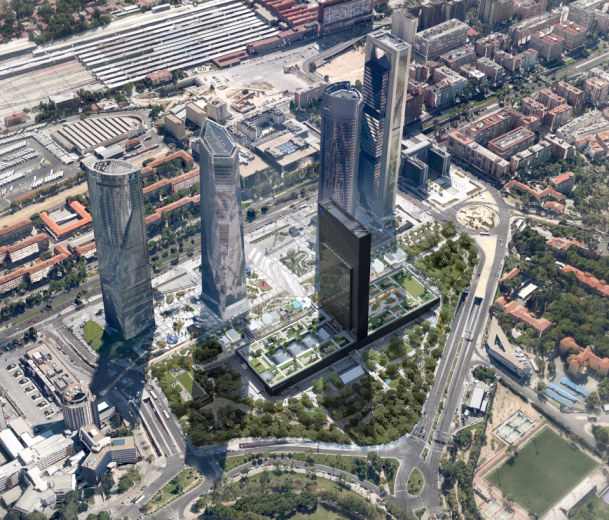 © Caleido
© Caleido
Although this complex is known as Cuatro Torres (Four Towers) Business Area, the fifth tower is currently under construction and will soon be completed. These skyscrapers by internationally acclaimed architecture firms accommodate offices, a prestigious hotel, Campus IE (Instituto de Empresa) and landscaped areas. The construction of these tall towers began in 2004 as part of a larger and ambitious masterplan for the northern area of Madrid. Proyecto Madrid Nuevo Norte aims to regenerate this former industrial area of Madrid, which includes Chamartín Station, and the abandoned spaces in the vicinity to the north. Read more here.
Architects: Pei Cobb Freed & Partners (Torre Espacio), Cesar Pelli (Torre de Cristal), Carlos Rubio Carvajal and Enrique Álvarez-Sala Walter (PwC Tower), Foster + Partners (Cepsa Tower) and Fenwick Iribarren Serrano-Suñer Arquitectura (CALEIDO)
Location: Paseo de la Castellana, 259D, 28046 Madrid (Google)
Year: 2008
2. Castelar Tower
 © Virginia Duran
© Virginia Duran
This much-loved building is known for its dramatic façade cantilever. Its 11 floors are supported in a single concrete core that is not located in the centre – where it would normally be. Another beautiful detail is the entrance to the building, a fine staircase made of travertine marble, which is public. The complex has been refurbished several times, being 2010 the most notable intervention. The Castelar building is named after the square where it is located, dedicated to the politician Emilio Castelar and located on Paseo de la Castellana. Castelar Tower is an early example by Rafael de la-Hoz architects, a practice founded in 1920. The style evolution, always towards a more sustainable architecture typology, is remarkable as you might see with their other constructions in the capital. You can visit its interior during Open House Madrid. Read more here.
Architect: Rafael de la-Hoz
Location: Paseo de la Castellana, 50, 28046 Madrid (Google)
Year: 1983
3. The Pavilion
 © Luis Asín
© Luis Asín
The Norman Foster Foundation is located in a protected palace designed by Joaquín Saldaña in 1912 for the Duke of Plasencia. The Norman Foster Foundation houses the Norman Foster Archive and Library, which offer a window on the history of our built environment through the work of the prestigious British architect, Norman Foster (Manchester, 1935). The 4-storey building has eight exhibition halls, where over 74,000 models, drawings, plans, photographs, notebooks, films and works of art can be seen, as well as spaces for study, from where the future tendencies in the world of architecture and design are explored and identified. Read more here.
Architect: Norman Foster Foundation
Location: Calle del Monte Esquinza, 48, 28010 Madrid (Google)
Year: 2017
4. Escuelas Pias de San Anton (COAM)
 © Jorge Crooke Carballal
© Jorge Crooke Carballal
The former Colegio de las Escuelas Pías de San Antón, later used as a school, has been transformed into a multifunctional space. This superb refurbishment now houses the new COAM headquarters (The Spanish equivalent of RIBA), the Architecture Foundation, Architecture Institute, postgraduate education centres, a library, History Service, an exhibition hall and a shop. The San Antón church from the old hospital, built by Pedro de Ribera in 1753, still stands. The exterior of the building, kept original, stands out thanks to its facade, designed by Ventura Rodríguez and known as Fuente de los Delfines (Fountain of the Dolphins), built between 1770 and 1772 and refurbished in 1900. Read more here.
Architect: Estudio Gonzalo Moure
Location: Calle de Hortaleza, 63, 28004 Madrid (Google)
Year: 2012
5. EspacioSOLO
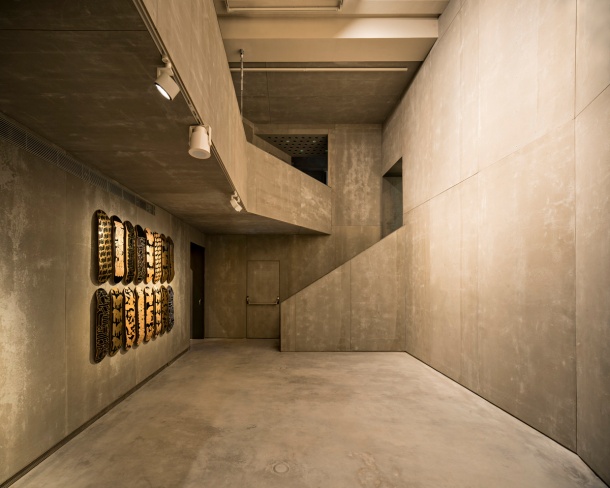 © Estudio Herreros
© Estudio Herreros
EspacioSolo, an exciting and young gallery founded by Ana Gervás and David Cantolla, showcases international contemporary art in their new premises besides the Retiro Park in Madrid. Estudio Herreros designed a circular, labyrinth-like structure of EspacioSOLO with the aim to make the visitors lose their way. Instead, they gradually discover each room and enjoy what’s happening inside without a predetermined direction. The artworks, always visible, merge with space itself, transporting visitors to worlds they have never before experienced. Read more here.
Architect: Estudio Herreros
Location: Plaza de la Independencia, 5, 28001 Madrid (Google)
Year: 2017
6. CaixaForum
 © Ruben Perez Bescos / Courtesy of CaixaForum
© Ruben Perez Bescos / Courtesy of CaixaForum
CaixaForum Madrid is perhaps one of the most successful buildings of Madrid, both architecturally and socially. The site, a narrow plot behind busy Castellana Avenue, had a pre-existing building that had to be incorporated. Its location and proximity to other museums and Retiro Park was a challenge and an opportunity. Herzog & de Meuron planned a most successful strategy, opening the building and creating a plaza, adding a vertical garden (Patrick Blanc) to attract visitors and subtly elevating the building which would also make for a distinguished entrance. Other details such as the white concrete staircase and the always-ageing corten-steel make this sociocultural centre one of the best additions to the Spanish capital. Read more here.
Architect: Herzog & de Meuron
Location: Paseo del Prado, 36, 28014 Madrid (Google)
Year: 2008
7. Medialab-Prado
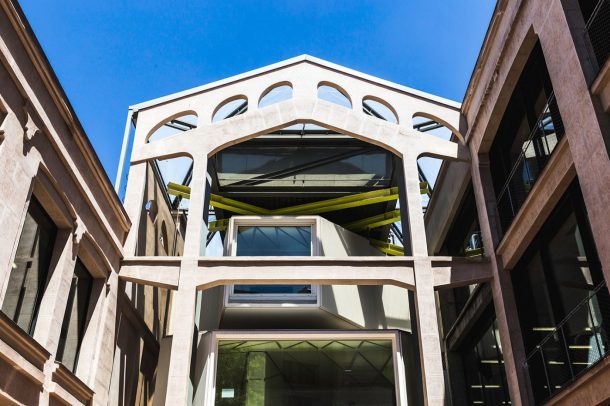

© Miguel de Guzmán
Medialab-Prado, sometimes abbreviated MLP, is a cultural space and citizen lab exploring the production and dissemination of art and digital culture. Since April 2013 it is located in the Serrería Belga, or The Belgian Sawmillone, of the few industrial architecture buildings that survive in the city of Madrid. The facade of the old building was left intact and a more flexible structure was inserted inside, which they nicknamed La Cosa, or The Thing. In this space workshops, open laboratories, meetings and lectures take place. The digital facade of 10×15 meters facing north towards Letras square features an interactive projects program. Read more here.
Architect: Langarita Navarro Arquitectos
Location: Calle de la Alameda, 15, 28014 Madrid (Google)
Year: 2008
8. Museo Nacional Centro de Arte Reina Sofía
 © Astudio
© Astudio
The Reina Sofía Museum, Madrid’s contemporary art museum par excellence, is housed in the Old Madrid General Hospital, which was built by Francisco Sabatini. In the early 2000s French architect Jean Nouvel led an expansion project which saw the erection of an auditorium, a library and new galleries inside a huge red building made from zinc and aluminium, which is adjacent to the old edifice. Its collection, which comprises over 22,400 works, spans much of the 20th century and is divided into three sections. In Room 206 you’ll find one of the museum’s highlight: Picasso’s masterpiece Guernica. Read more here.
Architect: Jean Nouvel
Location: Calle de Santa Isabel, 52, 28012 Madrid (Google)
Year: 2005
9. Mercado Barceló
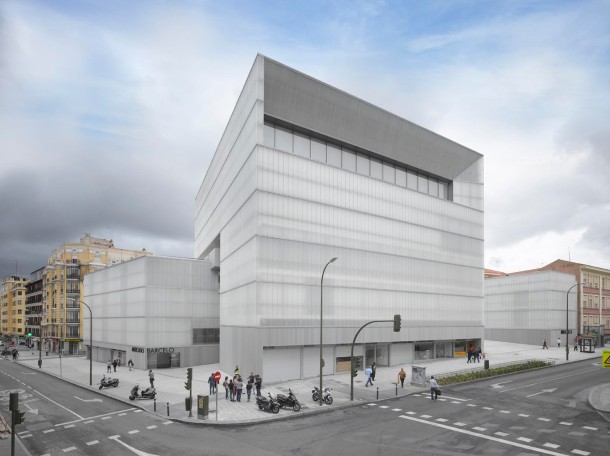 © Roland Halbe
© Roland Halbe
Barceló Market, a multipurpose complex made of a market, library and sports hall, is located on a most interesting area on the boundary between the historic centr of Madrid and its later expansion. Separated by a narrow interior gallery in the form of a street, the sports pavilion juts out over the market, whose roof is actually a large raised public terrace from which one sees the Madrid roofscape. On the other side, a cantilevered library rises above a schoolyard. A skin formed by large pieces of cast glass – white and opaline – unifies its exterior appearance, thus lending lightness and unity to the complex. Read more here.
Architect: Nieto Sobejano Arquitectos
Location: Calle Barceló, 6, 28004 Madrid (Google)
Year: 2014
10. ABC Museum
 © Virginia Duran
© Virginia Duran
This unassuming museum, which hides behind a courtyard, is perhaps my favourite building of Madrid. The original structure, a classical 1900’s building with ornate steel pillars, was erected for the Mahou brewery in Madrid. Spanish architect and urban planner José López Salaberry was known for his theatres (check Teatro El Doradoand the Teatro Fontalba) and one can see the resemblance between those and this brewery as he put in the same care. In 2014, Aranguren & Gallegos carried out an extensive restoration which not only renovated the space for its new use, but also beautified the urban setting by providing the city with an innovative building that respects its original architecture. Read more here.
Architect: Aranguren & Gallegos Architects
Location: Calle de Amaniel, 29, 28015 Madrid (Google)
Year: 2014
11. Centro Cultural Escuelas Pías de Lavapiés
 © IMAGENSUBLIMINAL
© IMAGENSUBLIMINAL
These ruins are part of the first school founded in Madrid by the Order of the Scolopi in 1729. The school that was intended for poor children soon became renowned for its high standards and innovative educational techniques: the first school in the country for deaf and dumb children was founded here. The only parts of the building left today are the ruins that initially formed part of the school chapel, built between 1763 and 1791 by Brother Gabriel Escribano and destroyed in 1936, during the early days of the Civil War. The enormous semicircular arch, designed by Alfonso Vergaz and crowned with the Pious Schools coat of arms, can still be seen today. Renowned architect, Linazasoro, was in charge of restoring this monastery and turning it into a library in 2004. The building now houses the UNED (National Distance Education University) head offices, with a large library, auditoriums and assembly halls. Read more here.
Architect: José Ignacio Linazasoro
Location: Calle de Tribulete, 14, 3rd floor, 28012 Madrid (Google)
Year: 2004
12. Spanish Cultural Heritage Institute (IPCE)
This Brutalist masterpiece located in the Ciudad Universitaria, was commissioned to architects Fernando Higueras and Antonio Miró in 1965. The IPCE (Spanish Cultural Heritage Institute) is a four-storey reinforced concrete colossus which stands out for its circular plan and a cornice with sharp spikes. In fact, it is popularly known as the Crown of Thorns. Construction started in 1967 but it took several years until it got finished. In 1970, 4 months before its completion day, construction stopped leaving it unfinished for a long time. And it wasn’t until 1990 that the building completed its construction. The building’s form is a 40m radius circle divided into 30 sections and 56 frames. Read more here.
Architect: Antonio Miró Valverde and Fernando Higueras
Location: Calle Pintor el Greco, 4, 28040 Madrid (Google)
Year: 1990
13. Arganzuela Footbridge
 © Wowabouts
© Wowabouts
Arganzuela Footbridge, completed in 2012, is one of the architectural icons of Madrid Río, the large park that runs along both banks of the Manzanares River as it flows through the city. The design of this modern bridge is a double metal spiral in the form of a ringlet with two arms, covered by metallic mesh that shines during the day and is illuminated at night by streetlamps designed to look like birds and butterflies. Inside there are wooden floors, benches to sit down for a rest, and a bike lane running right the way over it as part of the network that goes around the whole park. Arganzuela Footbridge links the districts of Carabanchel and Arganzuela. Read more here.
Architect: Dominique Perrault Architecture
Location: Av del Manzanares, 134, 28019 Madrid (Google)
Year: 2012
14. BBVA Headquarters
 © Rubén P. Bescós
© Rubén P. Bescós
BBVA, one of the largest financial institutions in the world, was known for its superb 1981 building by Sáenz de Oíza. These new headquarters, located on the northern periphery of Madrid, came with high expectations. La Vela (The Sail), an elliptical tower standing 93 metres high, is the main feature of the complex, which is made by a series of seven buildings. They are surrounded by gardens and landscaped areas, designed in accordance with the most demanding principles of sustainability, with native plant species that require little water and glass surfaces to maximise solar energy. From the distance, it looks like a noble landmark but it’s when one visits the place in person (and sees the crammed emergency staircases pushed towards the edges of the ovoidal form) that realises its disastrous and contradictory design execution. Read more here.
Architect: Herzog & de Meuron
Location: Calle Azul, 4, 28050 Madrid (Google)
Year: 2015
15. OXXEO Building
 © Alfonso Quiroga
© Alfonso Quiroga
OXXEO Building, completed in 2019 as an office space, is amongst Rafael de La-Hoz’s most successful office designs: Campus Repsol (2014), Telefonica Headquarters (2008) and Castelar Tower (1987). The evolution of these office spaces in the context of the firm is remarkable. OXXEO Building, with five storeys, stands out for the structural lattice of the façade with a rhomboidal mesh designed with metallic elements comprising a tubular section. The points of intersection of the mesh, which are located every 8.10 m, act as supporting elements on the perimeter of the slabs. In order to provide flexibility to the floor plan of the building, the design aimed to avoid setting pillars in the office space. Read more here.
Architect: Rafael de La-Hoz Arquitectos
Location: Calle Puerto de Somport, 9, 28050 Madrid (Google)
Year: 2019
16. Edificio Mirador
In 2005 and 2009 MVRD and Blanca Lleó completed two social housing blocks in this emerging part of Madrid, which is increasingly packed with offices. Mirador Building (2005), the first of these two, is 63.4 meters tall and has 21 floors and 155 apartments. The most prominent feature is the big central opening with a common area with gardens that also serves as a lookout thanks to the views of the Guadarrama mountains. Its shape is inspired in the typical block, then turned and put in a vertical angle. The superb concept was diminished by the budget constraints towards the end of its construction. Nearby Celosia Building (2009) didn’t even achieve that and lies in a state of semi abandonment. Read more here.
Architect: MVRDV + Blanca Lleó
Location: Avenida de Francisco Pi y Margall, 28050 Madrid (Google)
Year: 2005
17. Torres Blancas
Designed by Francisco Javier Sáenz de Oiza and completed in 1969, this concrete tower rises up 71 metres into the Madrid skyline. It is one of the most complicated and innovative concrete structures of its time, breaking with the typical conventions of residential architecture. When building Torres Blancas, the aspiration of Oiza was to build a unique residential building, of a great height, which would grow organically like a tree. The result was a structure that was covered vertically by staircases, lifts, and installations, like the vessels of a tree, surrounded by curved balconies grouped in the manner of leaves on branches. There is a large swimming pool on the roof terrace. Read more here.
Architect: Francisco Javier Sáenz de Oiza
Location: Avenida de América, 37, 28002 Madrid (Google)
Year: 1969
18. German School Madrid
 © Celia de Coca
© Celia de Coca
Deutsche Schule Madrid is a German international school completed in 2015. In this large complex, the school’s diverse areas of use are legible as clearly defined units. The individual buildings – the kindergarten, the primary school and the secondary school – each frame an inner courtyard. All patios open up to the surrounding landscape and a vista of the snow-covered mountains. With its special education program and evening theatre performances and concerts, the German School Madrid is an important site for cultural exchange. Read more here.
Architect: Grüntuch Ernst Architects
Location: Calle Monasterio de Guadalupe, 28049 Madrid (Google)
Year: 2015
19. Selgascano Office
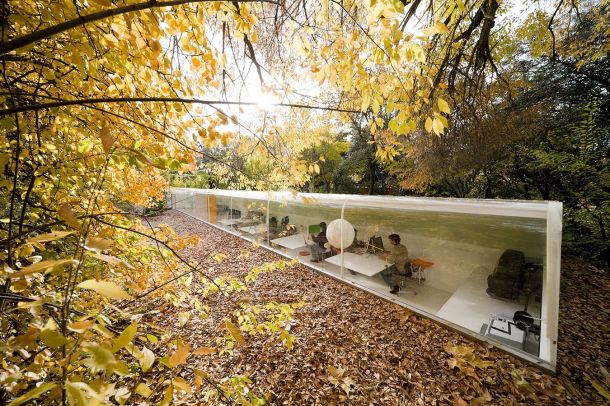 ©Iwan Baan
©Iwan Baan
Spanish architects Jose Selgas and Lucia Cano, known for their Serpentine Pavilion of 2015, have designed an office for their own practice, located in the woods near Madrid in Spain. A 20 mm thick, curved window made of transparent acrylic forms the north-facing wall of the tunnel-like space. The opaque, south-facing aspect is constructed from a 110 mm thick, insulated, fiber-glass and polyester sandwich, offering shade from direct sunlight. A hinged opening attached to a weighted pulley mechanism at one end of the building allows varying degrees of natural ventilation. Read more here.
Architect: Selgascano
Location: Calle Guecho, 27, 28023 Madrid (Google)
Year: 2007
20. Hospital Universitario Rey Juan Carlos
Besides innovative office spaces, Rafael de La-Hoz Arquitectos, have been involved in the construction of a new hospital model. Though obvious, most public hospitals lack these three basic elements: efficiency, light and silence. Completed in 2012, Hospital Universitario Rey Juan Carlos, is arranged to give structure to the health care units, outpatient diagnosis and treatments. It is then structured in three modules or parallel buildings that reflect the best hospital arrangement: flexibility, expansion, functional clarity and horizontal circulations. The position of the two towers responds to the functional need to have immediate access to the operating rooms, delivery rooms, emergency and diagnostic. Read more here.
Architect: Rafael de La-Hoz Arquitectos
Location: Calle Gladiolo, s/n, 28933 Móstoles, Madrid (Google)
Year: 2012
21. Parish Church of Santa Monica
The Parish Church of Santa Monica, completed in 2007, integrates, in only one building, all the spaces that correspond to the Church, Parish offices and priest housing. The generating idea of the project was that of situating, within the confusion of the surrounding urban environment, a building that would mark a milestone and become a continuous testimony to the spiritual function produced in its interior, and which must necessarily spread and manifest itself permanently to the nearby social and urban medium. The intention to unify had priority in the conception of the building, that is long and narrow, curved to fit the road along its westerly aspect and cut off abruptly at the north-easterly face. Read more here.
Architect: Vicens + Ramos
Location: Calle Libertad, 17, 28523 Rivas-Vaciamadrid, Madrid (Google)
Year: 2009
22. Wanda Metropolitano Football Stadium
 © FCC
© FCC
The recently-completed Wanda Metropolitano in Madrid by Cruz y Ortiz Architects has been named as the best stadium in the world during the World Football Summit 2018. The stadium was opened in September 2017 and is set to host the 2019 UEFA Champions League final in May of 2019. In awarding the accolade, the jury praised the scheme’s aesthetics, operational program, flexibility to hold a wide range of events, use of technology, and “above all, a unique experience for the spectator in terms of comfort, services, and safety.” Read more here.
Architect: Cruz y Ortiz Arquitectos
Location: Av. Luis Aragones, 4, 28022 Madrid (Google)
Year: 2017
23. Madrid-Barajas Airport Terminal 4
 © Rogers Stirk + Harbour
© Rogers Stirk + Harbour
Terminal 4 at the International Madrid-Barajas Airport is located three kilometres north of the old Barajas terminals T1, T2 and T3. The original design concept, completed in 2006, has been maintained in the final building and replies to the complex and extensive requirements of the specification and organising activity within three buildings: A car park, a Terminal Building and the Satellite Building. The Terminal Building is characterised by three linear modules – check-in spine, processing spine, Pier – and serves different functions according to the passengers’ flow (arrivals or departures). Almost everything was custom made and one can find some remarkable pieces of design, from the ventilation shafts to the lighting system. Read more here.
Architect: Estudio Lamela & Rogers Stirk Harbour + Partners
Location: Madrid-Barajas Airport, 28042 Madrid (Google)
Year: 2006
Check these and other amazing buildings of Madrid on the map below or download the Free Architecture Guide of Madrid (PDF):
 ©
©  ©
©  ©
©  ©
© 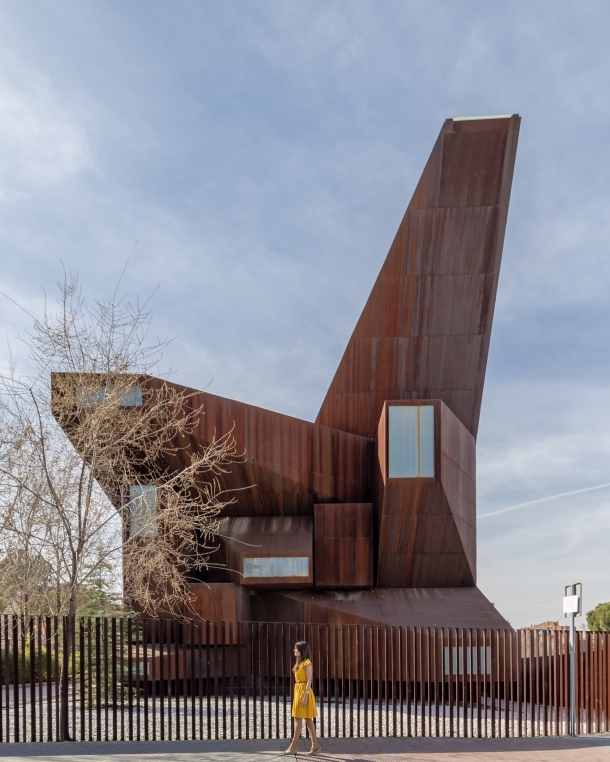 ©
©
Pingback: The Free Architecture Guide of Madrid (PDF) | Virginia Duran
Pingback: The Most Bizarre Concrete Building in Madrid | Virginia Duran
Pingback: Top 11 Rooftops of Madrid | Virginia Duran
Pingback: 5 Skyline Photographs of Madrid | Virginia Duran
Thanks for putting it together, Virginia. I can’t wait to see when we can travel again. I’m afraid this year we may have to stay in the countries where we’re staying.
Stay healthy, love from Susanne
LikeLiked by 1 person
I hope you can at least do your summer trip! We were going to travel to Spain in June and I think we have to cancel that.
By the way, I am thinking a lot about what you said to wake up really early to walk in the empty streets. I haven’t been out yet but will maybe do so soon. How are you? Love from London, Virginia
LikeLike
I hope so too, August is still a while away.
I’m keeping my fingers crossed that you can go to Spain in June, but it seems unlikely to me. Maybe everything will start up again in July?
Have you been strolling around London in the morning? What do you see on your walks? Isn’t it a good time to photograph architecture in London deserted?
I’m just cleaning up my studio. I have a request for a certain picture and had to search for it. After 1 1/2 hours I found it in a folder and tidied 4 drawers of my graphic cabinet by the way!
Be well and stay healthy, Susanne
LikeLike
Yeah, I think my trip would be cancelled, we’ll see. I haven’t been out of the house yet out of fear (18 days!) but I think soon. How is the studio cleaning going? I am actually doing the same. My working space looks so different. I am finding stuff that is many years old like furniture designs that have been completed, it’s nice to see the first designs. Do you live and work in the same building? Also, you must have so many drawings by now. Do you keep them all?
LikeLike
Good morning, Virginia,
I read this morning that even the Queen has now turned to her people. Does it show how serious the situation is?
Perhaps “cleaning” is not the right word, but rather sorting. I’ve re-sorted the drawings in my graphics cabinets, found what was lost and discarded others. I have also done my bookkeeping, so I can hand in my taxes very early this year. Yes, I work and life in my studio. I have a privat and a public area in the studio. I like this situation. 🙂
Today is bright sunshine in Berlin and I will sit on my balcony and enjoy the sun.
A beautiful Sunday from Susanne
LikeLiked by 1 person
Hello Susanne,
Yes, the Queen has had to speak heheh. Also, Boris Johnson is very ill now so I think people are seeing more the reality of what it is.
I am happy to read that you can work and live in the same space so this confined time is offering you both possibilities, it sounds very nice (also the re-sorting sounds enjoyable).
But most importantly today HAPPY BIRTHDAY!!! I know you’d rather be doing other plans but I wish you a great day with your favourite food and favourite drinks and I hope there’s some sun today in Berlin 🙂
LikeLike
Thank you, dear Virginia.
My friend and I had French apple pie with lots of cream on the balcony. I baked that cake. Baking is fun.
It was a beautiful day.
Many greetings from Susanne
LikeLiked by 1 person
Your posts are a wonderful way to travel virtually. Thank you!
LikeLiked by 1 person
Very glad to read this. 17 days without leaving my home at all! How are you?
LikeLiked by 1 person
Vancouver has been in a state of emergency since March 18th. Schools and universities are closed and all classes are now online. Only essential stores – grocery & pharmacies are open. We are living in interesting times and have come upon an unanticipated disruption. I believe it is our friendships and support for each other will have deeper meaning as events unfold. Take good care of yourself. This too will pass…. Hugs!
LikeLiked by 1 person
That’s interesting. Here in the UK is exactly the same, although we were closer to Italy than you, perhaps we reacted slowly. Prince Charles and Boris Johnson have it and I am still thinking whether it’s true or a tool to send a specific message to all of us. I couldn’t agree more with you regarding supporting each other. Virtually then, I send you a slice of the cake I just made and a big hug 🙂
LikeLiked by 1 person
Oh, the cake is delicious. I am enjoying my piece with a cup of tea. Thank you, my dear friend. Stay safe!!!
LikeLiked by 1 person
heheh this made me smile from ear to ear. Happy weekend – not that it makes any difference – but wanted to wish you something nice 🙂
LikeLiked by 1 person
I’ve been in Madrid many times and love this city with all its beautiful places… great architecture and cool people… I will miss it for long:( till all the disaster pass. Congrats for your post!
LikeLiked by 1 person
Thanks for your kind words and I am very happy you enjoyed Madrid. I am from the city myself 🙂
What was your favourite thing? Hopefully, all this madness will pass at some point this year and we’ll be able to travel again.
LikeLike
Hi , Virginia, i liked the vibe of Madrid in general. Looks young and alive… i hope we really could travel soon. If you don’t mind pass to take a look at my blog:)
LikeLiked by 1 person
I did and liked many of your posts, super interesting. I love fashion as one of the many forms of design, so by extension I am loving your blog 🙂
LikeLiked by 1 person
Ms. Duran, Greetings from a fan in Portland, Oregon, USA. I am enthralled by your guides. I am not an architect, but when I travel, I mostly focus on architecture, public plazas, and museums, of course. And always look for modern design gems. I was in Madrid for the first time, in November, but I had not seen this post, so now I’m eager to get back. And coincidentally, I recently encountered a young man here in Oregon who is from Madrid and whose father works with Moneo. (I was surprised that there are no Moneo or Calatrava buildings in Madrid that passed your test…). Is there any way to connect with you directly?? I would enjoy trading notes, though I imagine you are too busy for this. Respectfully, Chris Beck _____________________________Chris Beck, mthood1@aol.com735 SW St Clair Ave., #1009 Portland, ORphone/text: 503-274-1517
LikeLiked by 1 person
Hello Chris, nice to connect. Just accepted your request on LinkedIn. Very glad to read that you liked the article and that you were able to visit Madrid recently. Moneo is great but his best projects (like the Archaeologic Museum in Mérida) are not in Madrid. Calatrava? Ha, I have not much respect for this architect and the only ‘thing’ he did in Madrid is a sculpture in Plaza Castilla that actually doesn’t work. Curious to listen to your impressions of Madrid: What surprised you? What buildings/streets did you like most? Is there a place you missed and want to visit next time? All the best, Virginia
LikeLike
Hey, this map is great!
Also the information you give.
I will be glad to know If you Do tours in all the amazing places you mentioned.
Thanks alot.
LikeLiked by 1 person
Hi Mussa, thanks for your beautiful comments and for appreciating my work. I do tours here in London where I live https://architectourguide.com/collections/architectour-tours are you around town aoon?
LikeLike